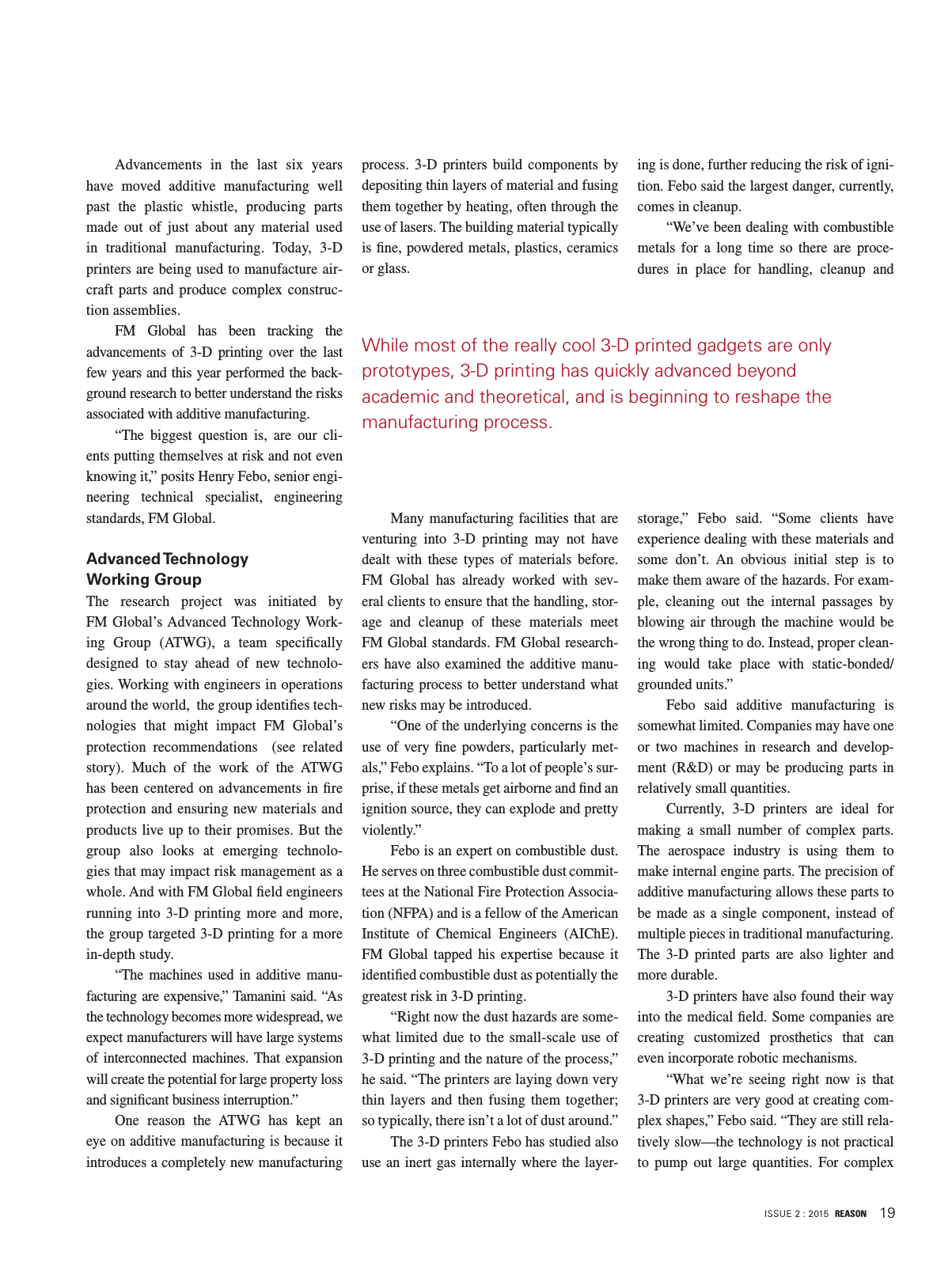Advancements in the last six years have moved additive manufacturing well past the plastic whistle producing parts made out of just about any material used in traditional manufacturing Today 3 D printers are being used to manufacture air craft parts and produce complex construc tion assemblies FM Global has been tracking the advancements of 3 D printing over the last few years and this year performed the back ground research to better understand the risks associated with additive manufacturing The biggest question is are our cli ents putting themselves at risk and not even knowing it posits Henry Febo senior engi neering technical specialist engineering standards FM Global Advanced Technology Working Group The research project was initiated by FM Global s Advanced Technology Work ing Group ATWG a team specifically designed to stay ahead of new technolo gies Working with engineers in operations around the world the group identifies tech nologies that might impact FM Global s protection recommendations see related story Much of the work of the ATWG has been centered on advancements in fire protection and ensuring new materials and products live up to their promises But the group also looks at emerging technolo gies that may impact risk management as a whole And with FM Global field engineers running into 3 D printing more and more the group targeted 3 D printing for a more in depth study The machines used in additive manu facturing are expensive Tamanini said As the technology becomes more widespread we expect manufacturers will have large systems of interconnected machines That expansion will create the potential for large property loss and significant business interruption One reason the ATWG has kept an eye on additive manufacturing is because it introduces a completely new manufacturing process 3 D printers build components by depositing thin layers of material and fusing them together by heating often through the use of lasers The building material typically is fine powdered metals plastics ceramics or glass Many manufacturing facilities that are venturing into 3 D printing may not have dealt with these types of materials before FM Global has already worked with sev eral clients to ensure that the handling stor age and cleanup of these materials meet FM Global standards FM Global research ers have also examined the additive manu facturing process to better understand what new risks may be introduced One of the underlying concerns is the use of very fine powders particularly met als Febo explains To a lot of people s sur prise if these metals get airborne and find an ignition source they can explode and pretty violently Febo is an expert on combustible dust He serves on three combustible dust commit tees at the National Fire Protection Associa tion NFPA and is a fellow of the American Institute of Chemical Engineers AIChE FM Global tapped his expertise because it identified combustible dust as potentially the greatest risk in 3 D printing Right now the dust hazards are some what limited due to the small scale use of 3 D printing and the nature of the process he said The printers are laying down very thin layers and then fusing them together so typically there isn t a lot of dust around The 3 D printers Febo has studied also use an inert gas internally where the layer ing is done further reducing the risk of igni tion Febo said the largest danger currently comes in cleanup We ve been dealing with combustible metals for a long time so there are proce dures in place for handling cleanup and storage Febo said Some clients have experience dealing with these materials and some don t An obvious initial step is to make them aware of the hazards For exam ple cleaning out the internal passages by blowing air through the machine would be the wrong thing to do Instead proper clean ing would take place with static bonded grounded units Febo said additive manufacturing is somewhat limited Companies may have one or two machines in research and develop ment R D or may be producing parts in relatively small quantities Currently 3 D printers are ideal for making a small number of complex parts The aerospace industry is using them to make internal engine parts The precision of additive manufacturing allows these parts to be made as a single component instead of multiple pieces in traditional manufacturing The 3 D printed parts are also lighter and more durable 3 D printers have also found their way into the medical field Some companies are creating customized prosthetics that can even incorporate robotic mechanisms What we re seeing right now is that 3 D printers are very good at creating com plex shapes Febo said They are still rela tively slow the technology is not practical to pump out large quantities For complex While most of the really cool 3 D printed gadgets are only prototypes 3 D printing has quickly advanced beyond academic and theoretical and is beginning to reshape the manufacturing process ISSUE 2 2015 REASON 19

Hinweis: Dies ist eine maschinenlesbare No-Flash Ansicht.
Klicken Sie hier um zur Online-Version zu gelangen.
Klicken Sie hier um zur Online-Version zu gelangen.